This post may contain affiliate links. Read our disclosure policy here.
If you’re looking for low-sugar smoothies that taste delicious and pack nutrition, you’ve landed in the right post!
Below you’ll find a variety of recipes that yield thick, great-tasting smoothies without packing on the sugar or calories. And as a bonus, you’ll find some low-sugar smoothie bowls too!
How to Make a Low-Sugar Smoothie
Generally speaking, a smoothie that falls in the low-sugar category is either a veggie smoothie or the amount of fruit is significantly reduced.
These lower-sugar smoothies also do not contain fruit juices or dairy since these liquids contribute many grams of sugar.
When adding fruit to a low-sugar smoothie, the general rule of thumb is no more than one serving, and depending on the fruit, it can be ½ cup or 1 cup, 1 small piece, etc.
Low Sugar Smoothie Ingredients
Reducing sugar doesn’t mean your smoothie will have less flavor. On the contrary! Many low-sugar smoothies are both delicious and highly nutritious.
Below are some ingredients commonly used to make this type of smoothie:
- Frozen cauliflower: it’s tasteless in a smoothie and adds lots of nutrition and volume to make up for having less fruit.
- Frozen berries: a lower sugar ingredient that is highly nutritious, high in flavor, and lower in the glycemic index.
- Avocado: gives smoothies a thick and delicious texture and the benefits of healthy fats into your diet.
- Cinnamon: gives simpler smoothies flavor without any sugars.
- Vanilla extract: similar to cinnamon, it adds sweetness without any sugar!
- Unsweetened Greek yogurt: a great option for extra protein and creaminess in your smoothie instead of dairy.
- Beets: Packed with folates, this is a great ingredient to blend into your smoothies. A few pieces go a long way!
- Spinach: this superfood is a fantastic add-in to any smoothie recipe.
- Diced zucchini: similar to cauliflower in that it doesn’t have a strong flavor or odor and adds volume and nutrition to the smoothie.
- Unsweetened Coconut Flakes: delicious flavor with no added sugars!
- Nut Butters: they add flavor and calories but not sugars, and a little is a great way to make a smoothie more filling without extra sweeteners.
- Carrots: naturally sweet and lower in sugar than fruit with similar nutritional benefits.
- Citrus fruits: lemons, limes, grapefruit, and other citrus fruits are high in vitamins and naturally low in sugar, so they are great options for your smoothies. You can even zest it into the blender for all the flavor and none of the sugar.
- Protein Powder: they’re not all created equal, so make sure to select the best protein powder that fits your nutritional needs. Many are very flavorful and contain no added sugars.
- Cucumber: adds volume, moisture, fiber and almost not noticeable flavor wise especially when mixed with ½ banana.
- Chia Seeds: they’re high in fiber and omega 3s perfect for thickening up any smoothie without having to add a banana. Use 1-2 teaspoons per serving.
- Flax meal: another great way to thicken a smoothie without adding fruit as well as being an excellent source of fiber, omega 3s, and other nutrients. Use 1-2 teaspoons per serving.

How to Reduce Sugar in Smoothies
Great-tasting smoothies don’t need to be full of sugar or contain a lot of fruit. Reduce the amount of fruit in the smoothie to ½ cup up to 1 cup at most per serving. The best-kept secret is to swap fruit for frozen cauliflower. It’s nearly tasteless and adds volume while thickening your smoothie.
Another easy way to reduce sugar in smoothies is by using a lower-sugar liquid such as water or unsweetened plant-based milk for blending.
Omitting unnecessary added sugars such as honey, agave, and fruit juice will further reduce the sugar content in your smoothie.
Best Low Sugar Fruits for Smoothies
Fruit is a great way to naturally sweeten a smoothie and get fiber, vitamins, and micronutrients into your diet. Below is a chart that compares the sugar content of the top fruits used to make smoothies.
| Fruit | Serving | Sugar | Calories |
|---|---|---|---|
| Banana, sliced | ½ cup | 9g | 68 |
| Orange | ½ cup | 9g | 85 |
| Pineapple, chunks | ½ cup | 8g | 41 |
| Strawberries | ½ cup | 4g | 25 |
| Blueberries | ½ cup | 7g | 42 |
| Peaches, sliced | ½ cup | 12g | 50 |
| Raspberries | ½ cup | 3g | 32 |
| Triple berry mix | ½ cup | 5g | 30 |
| Mango, chunks | ½ cup | 12g | 50 |
| Kiwi | 1 med | 6g | 42 |
Low-Sugar Liquids for Smoothies
The best low-sugar liquid for smoothies is unsweetened plant-based almond milk or water since both have 0 grams of sugar per serving. Water is an easy ingredient to add, while almond milk offers a little more flavor and creaminess.
Try one of these:
- water
- unsweetened almond milk
- unsweetened oat milk
- skim milk
- coconut water
- unsweetened black coffee
- unsweetened herbal tea
Liquids to Avoid in Low-Sugar Smoothies
While fruit juices and flavored milk are popular additions to smoothies, they also carry a lot of added sugar per serving. Orange, apple, and cranberry juice are the highest contributors, between 24 and 30 grams of sugar per 8 oz/1 cup of liquid.
Other liquids to avoid are chocolate milk (up to 30g of sugar per cup) and sweetened plant-based milk (up to 28g of sugar per cup). Unflavored dairy milk has between 10 and 12g of sugars per cup that are naturally occurring in milk, but sugar is sugar nonetheless.
Low-Sugar Smoothie Recipes
Smoothies made with minimal amounts of sugar can taste great. The secret is the right combination of ingredients for both nutrition and flavor.
Here are my top low-sugar smoothie recipes to try, all yielding 1 serving each. Note: I linked the original recipe so you can learn to adapt your favorite smoothie recipes into a low-sugar version.



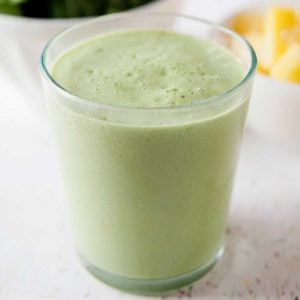





Low Sugar Smoothie Bowls
Love smoothies so thick you need to enjoy them with a spoon? I’ve got you covered with these low-sugar smoothie bowl recipes.
Here are my top low-sugar smoothie bowls to try, all yielding 1 serving each. Note: I linked the original recipes you can print. Toppings are not listed since those add sugars too.
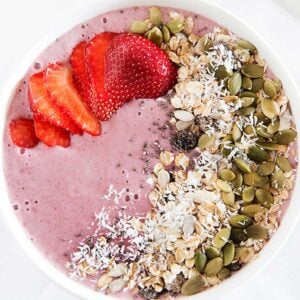


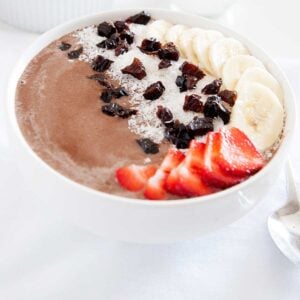

How to make low-sugar smoothies thicker
Smoothie recipes typically call for fresh or frozen fruit to accommodate for texture. Fresh fruit will yield a thinner/runnier smoothie than using frozen fruit. If your low-sugar smoothie lacks the desired texture and is too runny, you can make it thicker by adding 1-2 teaspoons of chia seeds, 1-2 teaspoons of flax meal, ice cubes, a scoop of protein powder, or even a teaspoon of coconut flour.
10 Low-Sugar Smoothies that Taste Great

Ingredients
- ½ cup frozen strawberries
- ½ cup frozen cauilflower florets
- ½ ripe banana, fresh or frozen
- 1 cup unsweetened plant milk
Instructions
- Place all the ingredients inside the blender jar, cover, and blend until smooth.
- Pour the smoothie into a cup and enjoy.





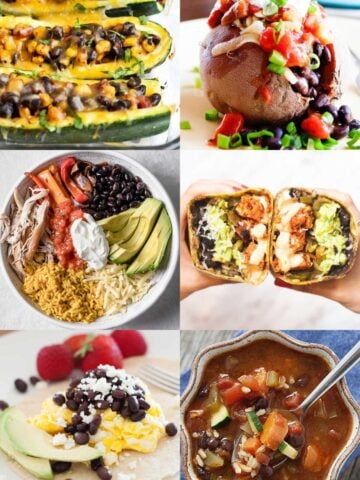
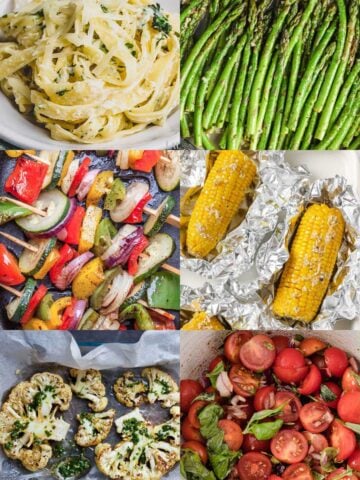
Laurie says
Looks yummy. Do you have a recommendation to replace the banana? I can’t have them.
Laura Fuentes says
swap for frozen cauliflower or avocado for a thick smooothie.
Dee says
These are so helpful and look so good! I didn’t realize that I’ve been putting WAY too much spinach and kale ♀️
Laura Fuentes says
A lot of people would say there’s no such thing as “too much” greens in a smoothie; however, my kids would disagree! Glad you found it helpful.